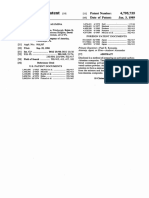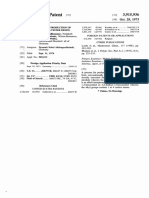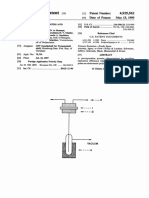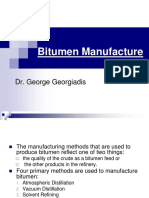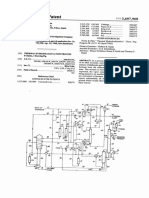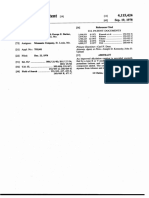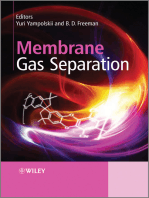0 ratings0% found this document useful (0 votes)
10 viewsUnited States Patent (19) : Symon Et Al. 45) Feb. 21, 1984
United States Patent (19) : Symon Et Al. 45) Feb. 21, 1984
Uploaded by
EceThis patent describes a process for purifying cyclohexane solvent. Cyclohexane is used as a medium for polymerizing olefinic hydrocarbons like 4-methyl-1-pentene to produce polymers useful for gas separation membranes. However, impurities in the cyclohexane can negatively impact the polymerization. The purification process involves treating cyclohexane with titanium tetrachloride, contacting it with silica gel, and then distilling it in the presence of an alkaline metal aluminum or borohydride purification agent to remove impurities.
Copyright:
© All Rights Reserved
Available Formats
Download as PDF, TXT or read online from Scribd
United States Patent (19) : Symon Et Al. 45) Feb. 21, 1984
United States Patent (19) : Symon Et Al. 45) Feb. 21, 1984
Uploaded by
Ece0 ratings0% found this document useful (0 votes)
10 views5 pagesThis patent describes a process for purifying cyclohexane solvent. Cyclohexane is used as a medium for polymerizing olefinic hydrocarbons like 4-methyl-1-pentene to produce polymers useful for gas separation membranes. However, impurities in the cyclohexane can negatively impact the polymerization. The purification process involves treating cyclohexane with titanium tetrachloride, contacting it with silica gel, and then distilling it in the presence of an alkaline metal aluminum or borohydride purification agent to remove impurities.
Original Title
ç
Copyright
© © All Rights Reserved
Available Formats
PDF, TXT or read online from Scribd
Share this document
Did you find this document useful?
Is this content inappropriate?
This patent describes a process for purifying cyclohexane solvent. Cyclohexane is used as a medium for polymerizing olefinic hydrocarbons like 4-methyl-1-pentene to produce polymers useful for gas separation membranes. However, impurities in the cyclohexane can negatively impact the polymerization. The purification process involves treating cyclohexane with titanium tetrachloride, contacting it with silica gel, and then distilling it in the presence of an alkaline metal aluminum or borohydride purification agent to remove impurities.
Copyright:
© All Rights Reserved
Available Formats
Download as PDF, TXT or read online from Scribd
Download as pdf or txt
0 ratings0% found this document useful (0 votes)
10 views5 pagesUnited States Patent (19) : Symon Et Al. 45) Feb. 21, 1984
United States Patent (19) : Symon Et Al. 45) Feb. 21, 1984
Uploaded by
EceThis patent describes a process for purifying cyclohexane solvent. Cyclohexane is used as a medium for polymerizing olefinic hydrocarbons like 4-methyl-1-pentene to produce polymers useful for gas separation membranes. However, impurities in the cyclohexane can negatively impact the polymerization. The purification process involves treating cyclohexane with titanium tetrachloride, contacting it with silica gel, and then distilling it in the presence of an alkaline metal aluminum or borohydride purification agent to remove impurities.
Copyright:
© All Rights Reserved
Available Formats
Download as PDF, TXT or read online from Scribd
Download as pdf or txt
You are on page 1of 5
United States Patent (19) 11) 4,433,194
Symon et al. 45) Feb. 21, 1984
(54) PURIFICATION OF CYCLOHEXANE 2,970,105 1/1961 Condo et al. ....................... 208/249
4,367,364 1/1983 Kulprathipanza et al.......... 585/826
(75) Inventors: Ted Symon, Lombard; Dusan J.
Engel, Des Plaines, both of Ill. Primary Examiner-Delbert E. Gantz
(73) Assignee: UOP Inc., Des Plaines, Ill. Assistant Examiner-Chung K. Pak
Attorney, Agent, or Firm-James R. Hoatson, Jr.;
(21) Appl. No.: 492,306 Raymond H. Nelson; William H. Page, II
22 Filed: May 6, 1983 57 ABSTRACT
(51) Int, Cl. ....................... B01D 3/34; C10G 29/12; Solvents which may be used as mediums for the poly
C07C 17/38; CO7C 21/00 merization of olefinic hydrocarbons to form polymers
(52) U.S. Cl. .................................... 585/803; 585/807; useful as membranes in a gas separation process require
585/827; 585/836; 585/853; 203/29; 203/32; purification to remove any impurities which will effect
203/33; 208/249 the aforesaid polymerization. Purification of these sol
58 Field of Search ............... 585/803, 807, 827, 836, vents such as cyclohexane may be effected by treating
585/853; 203/29, 32, 33, 45; 208/249 the solvent with titanium tetrachloride, contacting the
(56) References Cited solution with an adsorbent such as silica gel and thereaf
ter distilling the solvent in the presence of a purification
U.S. PATENT DOCUMENTS agent such as an alkaline metal aluminum hydride or
2,846,485 8/1958 Meason et al. ........................ 203/29 borohydride.
2,891,100 6/1959 Kron .............. 585/803
2,896,002 7/1959 Souillard ............................. 585/803 8 Claims, No Drawings
1
4,433,194
2
branes. In a similar manner, commercial poly(methyl
PURIFICATION OF CYCLOHEXANE pentene) when polymerized from 4-methyl-1-pentene
uses a titanium chloride catalyst which has been acti
BACKGROUND OF THE INVENTION vated with aluminum trialkyls, producing a polymer
The use of semipermeable membranes for reverse which is largely an isotactic material which possesses a
osmosis or ultrafiltration processes is well known. For poor solubility in solvents as well as being brittle and
example, in a reverse osmosis process saline water may relatively opaque in nature.
be passed through a semipermeable membrane which is In view of the disadvantages of the prior methods, it
permeable to water but relatively impermeable to salt, is necessary to effect the polymerization of 4-methyl-1-
thereby separating the brine in the water from the water 10 pentene under certain conditions whereby a polymer is
to afford relatively pure water which may be utilized obtained which may be utilized to prepare a membrane
for personal use such as drinking, cooking, etc. which will effectively act to separate various, gases. In
In addition to the separation of liquids, certain mem this respect, it has been discovered that undesirable
branes may also be utilized for the separation of various 15
characteristics present in the polymer which is obtained
gases. The separation of a gas mixture utilizing a mem by the polymerization reaction may be traced to impuri
brane is effected by passing a feed stream of the gas ties which are present in the solvent which is employed
across the surface of the membrane. Inasmuch as the as a medium in which the polymerization is effected. In
feed stream is at an elevated pressure relative to the order to overcome these disadvantages, it is necessary
effluent stream, a more permeable component of the to utilize a solvent which is free from impurities which
mixture will pass through the membrane at a more rapid 20
led to the preparation of unusable polymers.
rate than will a less permeable component. Therefore, As will hereinafter be shown in greater detail, it is
the permeate stream which passes through the mem now possible to purify a solvent such as cyclohexane
brane is enriched in the more permeable component whereby it may be effectively used in polymerization
while, conversely, the residue stream is enriched in the reactions involving olefins such as 4-methyl-1-pentene.
less permeable component of the feed. 25
This ability to separate gases from a mixture stream BRIEF SUMMARY OF THE INVENTION
will find many applications in commercial uses. For This invention relates to a method for the purification
example, gas separation systems may be used for oxygen of solvents. More specifically, the invention is con
enrichment of air, for improved combustion efficiencies cerned with a process or method for the purification of
and conservation of energy resources. Likewise, nitro 30
cyclohexane whereby undesirable impurities which
gen enrichment of air may be applicable where inert cause a deleterious effect in the polymerization of ole
atmospheres are required. Other applications for oxy fins are effectively removed.
gen enriched gases may be improving selectivity and
efficiency of chemical and metallurgical processes. Sim As was hereinbefore set forth, the separation of vari
ilarly, inert atmospheres such as may be provided for by 35 ous gases from mixtures thereof may constitute an im
this invention may also be utilized in chemical and met portant advance in commercial applications, this ad
allurgical processes. Some other applications of gas vance becoming increasingly important in view of the
separation would include helium recovery from natural necessity to conserve energy. One particular applica
gas, hydrogen enrichment in industrial process applica tion which would apply relates to increasing the ther
tions, and scrubbing of acid gases. Specific uses for mal efficiency of combustion processes when utilizing
oxygen enrichment of air would be breathing systems fossil fuels in commercial combustion applications. By
for submarines and other underwater stations, improved utilizing a gas separation membrane in processes such as
heart-lung machines, and other lung assist devices. An coal gasification, it may be possible to provide an oxy
other specific application of a gas separation system gen-enrichment of air for the production of low and
would be in aircraft to provide oxygen enrichment for 45 medium British Thermal Unit (BTU) reduction gases as
life-support systems and nitrogen enrichment for pro well as an oxygen enrichment of air for the combustion
viding an inert atmosphere for fuel systems. In addition, of these gases. For example, by placing a gas membrane
gas separation systems may be used for environmental separation system in close proximity to both gas pro
benefits, e.g. methane can be separated from carbon duction and gas combustion facilities, it would allow a
dioxide in waste gases from sewage treatment processes 50 site-located oxygen enrichment plant to supply both
and oxygen enriched air can be produced to enhance processes without the additional expense of transport
sewage digestion. ing the gas or duplicating any enrichment facilities. In
Among the thin film polymers which may be used for view of this, it is necessary to provide a gas separation
gas separation membranes are the poly(methylpen membrane which possesses excellent oxygen-nitrogen
tenes). However, the methylpentene and particularly 55 selectivities. One particular type of gas separation mem
4-methyl-1-pentene which is used to prepare the desired brane which possesses this characteristic comprises
membrane must possess certain characteristics which poly(methylpentene). This membrane is prepared by
will enable it to be utilized in the desired manner. Some polymerizing 4-methyl-1-pentene in the presence of a
prior methods to obtain a poly(methylpentene) utilized solvent medium, a particularly effective solvent com
various catalysts to effect the polymerization. One prior 60 prising cyclohexane. However, the solvent must be free
method employs a Ziegler-Natta type catalyst. When of any impurities which will effect the polymerization
utilizing a compound such as aluminum chloride in the to form the desired product.
polymerization reaction, the poly(methylpentene) is in It is therefore an object of this invention to provide a
the form of a sticky solid which is unsuitable for use in method for the purification of solvents which are uti
the preparation of membranes. Likewise, a catalyst 65 lized in polymerization reactions.
comprising aluminum triisobutyl-titanium tetrachloride A further object of this invention is to set forth a
produces a low molecular weight solid but brittle poly method for the purification of cyclohexane whereby
mer which is also unsuitable in the preparation of mem undesirable impurities are removed therefrom.
4,433,194 4.
3
In one aspect, an embodiment of this invention re fore synthesizing or polymerizing a solvent-soluble
sides in a method for the purification of cyclohexane poly(4-methyl-1-pentene), to obtain an oxygen-enrich
which comprises treating said cyclohexane with tita ment membrane, any impurities which are present in the
nium tetrachloride, contacting said treated cyclohexane saturated linear aliphatic hydrocarbons or alicyclic
with an adsorbent, subjecting said cyclohexane to frac hydrocarbons which are used as solvents can, to a great
tional distillation in the presence of a purification agent extent, influence the reaction rate of the polymerization
comprising an alkali metal borohydride or aluminum and therefore the solubility of the solvent-soluble poly(-
hydride to remove contaminants therefrom, and recov methylpentene).
ering the purified cyclohexane. Impurities which may be present in the solvent may
A specific embodiment of this invention is found in 10 comprise isoparaffins, olefins, both internal and external
the method for the purification of cyclohexane which in nature, aromatics, oxygen-and sulfur-containing com
comprises treating said cyclohexane with titanium tetra pounds, as well as water. Each impurity will act in a
chloride, contacting said treated cyclohexane with sil different fashion to influence the polymerization of the
ica gel, subjecting said cyclohexane to fractional distil desired olefin. For example, isoparaffins in general will
lation at pressures in the range of from about subatmo 15 act to slow down the reaction, while conversely, alpha
spheric to about atmospheric pressure in the presence of olefins will polymerize at a much faster rate than the
a purification agent comprising sodium borohydride to desired olefins undergoing polymerization and there
remove contaminants therefrom, and recovering the fore will contribute to a decrease in the selectivity of the
purified cyclohexane. membrane which is formed from the desired polymer
Other objects and embodiments will be found in the 20 ized olefin. Other impurities such as aromatics, water,
following further detailed description of the invention. oxygen- and sulfur-containing compounds will have a
tendency to react with the catalyst which is employed
DETALED DESCRIPTION OF THE for the polymerization process and therefore will deac
INVENTION tivate it.
As hereinbefore set forth, the present invention is 25 One method of reducing the amount of impurities.
concerned with a process for purifying solvents which which may be present in the solvent system is to treat
are utilized in a polymerization process involving 4 the solvent with sulfuric acid followed by neutralization
methyl-1-pentene to obtain a poly(methylpentene) poly with a basic compound, washing and drying followed
mer which possesses the necessary characteristics by distillation from a trialkyl aluminum compound.
which will enable it to be utilized in the preparation of 30 Another method of effecting a purification of the sol
a membrane, said membrane consisting of a finely per vent is to subject the solvent to a hydrogenation process
meable barrier composited on a finely porous support by treatment with hydrogen in the presence of a nickel
membrane which, if so desired, may be backed by a catalyst. In contradistinction to these prior methods of
fabric. By utilizing an imperfection-free semipermeable purifying a solvent system, it has now been discovered
membrane which has been prepared from the poly(- 35 that any impurities which are present in a solvent sys
methylpentene) prepared by a polymerization process tem such as cyclohexane may be effectively removed by
involving a solvent medium which is free from impuri a treatment hereinafter set forth in greater detail
ties, it is possible to effect a gas separation process in whereby the solvent system may be successfully em
which a selected gas or gases will pass through the ployed in a polymerization of specific olefins such as
barrier with little hindrance while other gases will be 40 4-methyl-1-pentene, to obtain a polymer which may be
less able to penetrate the barrier. The polymerized effectively used as a membrane in the separation of
poly(methylpentene) which is obtained from the poly gases, said membrane possessing an excellent selectivity
merization reaction may be utilized as a homopolymer value.
or, if so desired, copolymerized with a branched chain The purification of the solvent system is effected by
diolefinic hydrocarbon such as isoprene (2-methyl-1,3- 45 treating a solvent such as, for example, cyclohexane
butadiene), 2-methyl-1,3-pentadiene, 2-methyl-1,3-hex which has a purity in the range of from about 98% to
adiene, 2-methyl-1,3-heptadiene, 2-methyl-2,4-pentadi about 99.7% with anhydrous titanium tetrachloride, the
ene, 2-methyl-2,4-hexadiene, etc. Both the homopoly anhydrous titanium tetrachloride being present in an
merization and copolymerization of the reactants is amount in the range of from about 0.05% to about
effected in an organic solvent medium, the preferred 50 0.6%, and preferably in a range of about 0.1% to about
solvent for the reaction of this invention comprising 0.3% by weight of the solvent. In the preferred embodi
cyclohexane, although it is also contemplated that other ment of the invention, the treatment step is effected at
organic solvents such as cycloheptane, cyclooctane, ambient temperatures and atmospheric pressure, al
methylcyclopentane, methylcyclohexane, tetralin, hex though it is contemplated that elevated temperatures
ane, heptane, octane, etc. may be employed, although 55 and pressures may be used without deviating from the
not necessarily with equivalent results. scope of the invention. ...
It is well known that polymerization reactions of The addition of the titanium tetrachloride to the sol
olefinic hydrocarbons, such as the Ziegler-Natta type, vent will assist in the elimination of impurities such as
are sensitive to various types of impurities. Inasmuch as isoparaffins, olefins, aromatics, oxygen, or sulfur-con
the solvents which are utilized in these reactions are 60 taining compounds, by forming a yellow complex and
generally present in large quantities, it is imperative that Mora precipitate. In the event that some water is present
the solvent be free of impurities inasmuch as the pres in the solvent system as an impurity, a small amount of
ence of the impurities will have a significant and delete hydrochloric acid is also formed. The removal of these
rious effect regarding the degree of polymerization of impurities in the form of the complexes and/or precipi
the olefinic hydrocarbon as well as the structure of the 65 tates is effected by contacting the treated solvent with
polymer which is prepared, thus effecting its perfor an adsorbent, such as for example, by passing the sol
mance, in this case, as a membrane for the separation of vent through a column of active silica gel under a slight
gases. For example, in the polymerization process be pressure, that is, from about 0.5 to about 7 psi provided
1.
4,433,194
5 6
for by the introduction of a nitrogen atmosphere. Al temperatures in the range of from about ambient to
though the active silica gel constitutes the preferred about 50 C. and pressures which may range from about
adsorbent, it is also contemplated within the scope of atmospheric to about 1000 pounds per square inch (psi).
this invention that any other types of adsorbents known After the desired reaction time has elapsed, the reaction
in the art may also be employed to remove the com is quenched by the addition of a mixture of alcohols
plexes and the hydrochloric acid. Following passage such as methyl alcohol and isopropyl alcohol, filtered
through the active silica gel or other adsorbent, the from the quench solution and solvent and after washing,
effluent is then subjected to distillation, preferably in an the desired polymer is dried and recovered. As herein
inert atmosphere as provided for by a nitrogen blanket before set forth, by utilizing a solvent which has been
in the presence of a purification agent comprising an 10 purified according to the process of the present inven
alkali metal borohydride or aluminum hydride which tion, it is possible to effect the polymerization reaction
acts primarily as a reducing agent. Examples of these in such a manner so that the polymer which is obtained
purification agents which may be employed will include will possess a desirable molecular weight and a predom
compounds such as lithium borohydride, sodium boro inately crystalline structure which will enable its use as
hydride, potassium borohydride, rubidium borohy 15 a finely permeable barrier in the production of a mem
dride, cesium borohydride, lithium aluminum hydride, brane suitable for use in gas separation processes.
sodium aluminum hydride, potassium aluminum hy The following examples are given for purposes of
dride, rubidium aluminum hydride, cesium aluminum illustrating the process of the present invention in which
hydride. The aforementioned hydrides will be present an organic solvent suitable for use as a medium in a
in the solvent system in an amount in the range of from 20 polymerization reaction is purified to remove undesir
about 0.05% up to about 0.5% and preferably in a range able contaminants therefrom. However, it is to be un
from about 0.1% to about 0.3% by weight. By utilizing derstood that these examples are merely illustrative in
a distribution system involving the purification agent of nature and that the present process is not necessarily
the type hereinbefore set forth, it is possible to remove limited thereto.
any traces of hydrochloric acid or water which may 25 EXAMPLE I
still be present in the effluent from the percolation step
as well as to reduce any residual olefinic hydrocarbon In this example, 5 mL of anhydrous titanium chloride
impurities which may still have been present after treat was added to 3600 mL of a 99% pure cyclohexane,
ment with the titanium tetrachloride. After thorough admixture, the solution which was pale
While the aforementioned procedure for purifying 30 yellow in color was passed through a column of active
the solvent system is particularly effective for solvents silica gel of a mesh size of 100-200. After the effluent
which possess a purity of 98% or more, it is possible to had reached the bottom of the column, a nitrogen pres
purify solvents of less purity by a pretreatment proce sure of 7 psi was applied in order to facilitate the perco
dure prior to the aforementioned steps of contacting lation through the column. The effluent in an amount of
with titanium tetrachloride and contact with an adsor 35 2200 mL was mixed with 5 grams of lithium aluminum
bent followed by distillation in the presence of the puri hydride and subjected to distillation at a temperature of
fication agent. The pretreatment procedure which may about 40' C. under a reduced pressure of about 200 torr,
be employed for solvents having less than 98% purity the distillation being effected under a nitrogen blanket,
involves a washing of the solvent with a 1:1 sulfuric A portion of the distillate in an amount of 2 mL was
acid solution, neutralizing the washed solvent with tested by adding a drop of acetic acid and two drops of
sodium carbonate, water washing the solvent until a titanium tetrachloride. The solution remained clear,
neutral pH has been attained followed by drying with thus showing a negative test for the presence of impuri
anhydrous sodium sulfate and molecular sieves. Fol ties such as olefins, aromatics, hetero compounds and
lowing the pretreatment of the solvent, it may then be Water.
further purified according to the process of this inven 45 EXAMPLE II
tion. Likewise, it is also contemplated within the scope
of this invention that solvents which possess a purity To illustrate the utility of a solvent purified in accor
greater than about 99.7% may be purified by only distil dance with the method set forth in Example I above to
lation in the presence of a purification agent of the type act as a solvent for a polymerization reaction, 60 mL of
hereinbefore set forth, omitting the treatment with tita 50 cyclohexane which had been treated according to Ex
nium tetrachloride and subsequent contact with an ad ample I was injected into a nitrogen purged flask.
sorbent. Thereafter, 5 mL of a 1.0 M titanium tetrachloride solu
The solvent thus purified may be utilized in a poly tion in purified cyclohexane was also injected into the
merization reaction in which an olefinic hydrocarbon flask, no discoloration being observed and thus verify
such as, for example, 4-methyl-1-pentene is treated at 55 ing the absence of any contaminants. Following this, 25
polymerization conditions in the presence of a polymer mL of a 0.2 M lithium aluminum tetra(decyl) solution
ization catalyst. As an example, the olefinic hydrocar was injected and a brown precipitate formed in the
bon undergoing polymerization is placed in an appro flask. The feed stream comprising 20 mL of 4-methyl-1-
priate apparatus such as a reaction flask which is pro pentene and 0.2 mL of isoprene were injected into the
vided with heating and stirring means along with a flask and the reaction was allowed to proceed for a
polymerization catalyst lithium aluminum tetra(decyl) period of one hour. During this reaction period, dis
and the solvent such as cyclohexane. The polymeriza persed solids were formed in the reaction mixture. At
tion reaction is allowed to proceed in an inert atmo the end of the one hour period, the reaction was
sphere such as that afforded by the introduction of quenched by the addition of 50 mL of a solution con
nitrogen into the reaction flask for a predetermined 65 taining methyl alcohol and isopropyl alcohol. The
period of time which may range from about 0.5 up to solids were recovered and washed in a blender five
about 6 hours. The polymerization conditions which are times with methyl alcohol followed by drying in a high
employed to effect the desired reaction will include vacuum to yield 6.7 grams of a white powder. The
4,433,194 8
7
white powder which comprised poly(methylpentene) had reached the bottom of the column, nitrogen pres
was dissolved in cyclohexane and poly(methylpentene) sure of 7 psi was applied to aid in the percolation. The
films were cast from a 1% solution of the polymer in the effluent which was recovered from this step was ad
cyclohexane. The films were used to form a membrane mixed with 5 grams of sodium borohydride and sub
by casting the poly(methylpentane) film on one surface 5 jected to distillation under a reduced pressure of about
of a finely, porous support member comprising polysul. 200 torr at a temperature of about 40 C. A portion of
fone. The resulting membrane in which the poly(meth the distillate which was recovered was tested by adding
ylpentene) film had a thickness of 11,920 Angstroms a drop of acetic acid and 2 drops of titanium tetrachlo
was used in a single stage gas separation process. A feed ride. The solution remained clear and water-white, thus
stream comprising air was passed over the surface of the 10 showing that no impurities were present in the distillate.
membrane at a pressure of 20 psi and attemperature of We claim as our invention:
25 C. The selectivity factor which is a ratio of the 1. A method for the purification of cyclohexane
oxygen to the nitrogen flow was 4.2. . . . . which comprises treating said cyclohexane with tita
EXAMPLE III 15
nium tetrachloride, contacting said treated cyclohexane
In this example, a nontreated cyclohexane solvent with an adsorbent, subjecting said cyclohexane to frac
which showed a positive titanium tetrachloride test was tional distillation in the presence of a purification agent
used as a solvent in the polymerization of 4-methyl-1- comprising an alkali metal borohydride or aluminum
pentene. The 4-methyl-1-pentene was polymerized in a hydride to remove contaminants therefrom, and recov
manner similar. to that set forth in Example II above, 20 ering the purified cyclohexane.
and the poly(methylpentene) which was formed was 2. The method as set forth in claim 1 in which said
cast on a finely porous support member comprising distillation is effected at pressures in the range of from
polysulfone to form a gas membrane. The gas mem subatmospheric to about atmospheric pressure.
brane thus formed was used in a single stage gas separa 3. The method as set forth in claim 1 in which said
tion process under similar conditions to those hereinbe 25 adsorbent comprises activated silica gel. .
fore set forth. The membrane, while exhibiting a higher 4. The method as set forth in claim 1 in which said
permeability. to oxygen than to nitrogen, only had an purification agent comprises. sodium borohydride.
oxygen selectivity factor of 1.8. ". . 5. The method as set forth in claim 1 in which said
purification agent comprises potassium borohydride.
EXAMPLE IV 30 6. The method as set forth in claim 1 in which said
purification agent comprises lithium aluminum hydride.
In a manner similar. to that set forth in Example 1
above, 3600 mL of 99% pure cyclohexane was treated ...7. The method as set forth in claim 1 in which said
with 5 mL of anhydrous titanium chloride. The result purification agent comprises sodium aluminum hydride.
ing solution which was pale yellow in color was also 8. The method as set forth in claim 1 in which said
passed through a 2X30 mm column of activated silica 35 purification agent is lithium borohydride.
ak it is . . . . .. .
gel which had a mesh size of 100-200. After the effluent
45
50
55
65
You might also like
- Petroleum Refinery HSE ManualDocument11 pagesPetroleum Refinery HSE ManualFarrukh TouheedNo ratings yet
- United States Patent 19: Dumain Et AlDocument10 pagesUnited States Patent 19: Dumain Et AlFi FiyundaNo ratings yet
- Us 4058649Document6 pagesUs 4058649yigitilgazNo ratings yet
- Aluminum OxideDocument5 pagesAluminum OxideAlexandra EvangelistaNo ratings yet
- I - L - Lllllllllillll - LLLLLLLMLLLLLLLLLLLLLLLLLLLLLLLLLLLLLLLLLLLLLLLLLDocument10 pagesI - L - Lllllllllillll - LLLLLLLMLLLLLLLLLLLLLLLLLLLLLLLLLLLLLLLLLLLLLLLLLAnonymous S8y3ZMJNo ratings yet
- Us3850741 PDFDocument6 pagesUs3850741 PDFGandhi YellapuNo ratings yet
- Ulllted States Patent (10) Patent N0.: US 7,525,005 B2Document7 pagesUlllted States Patent (10) Patent N0.: US 7,525,005 B2nokarajuNo ratings yet
- US4142060-Rhone-Poulenc FranceDocument12 pagesUS4142060-Rhone-Poulenc France黃英婷No ratings yet
- Ulllted States Patent (19) (11) Patent Number: 5,849,981: Kulprathipanja (45) Date of Patent: Dec. 15, 1998Document8 pagesUlllted States Patent (19) (11) Patent Number: 5,849,981: Kulprathipanja (45) Date of Patent: Dec. 15, 1998rifkynoviyantoNo ratings yet
- United States Patent (19) (11) 3,835,199: Schwartz, Jr. Et AlDocument5 pagesUnited States Patent (19) (11) 3,835,199: Schwartz, Jr. Et AlandiNo ratings yet
- Us 5317036Document21 pagesUs 5317036Sushil Kumar RaoNo ratings yet
- Improve Contaminant Control in Ethylene Production: Hpimpact TechnologyDocument6 pagesImprove Contaminant Control in Ethylene Production: Hpimpact TechnologyVenkatesan DevendranNo ratings yet
- Joya Us4569799Document9 pagesJoya Us4569799Agustin CantilloNo ratings yet
- Us 3717672Document5 pagesUs 3717672eschim.civNo ratings yet
- United States Patent (191: StormoDocument18 pagesUnited States Patent (191: StormoPranav NakhateNo ratings yet
- United States Patent (19) : SouthwickDocument6 pagesUnited States Patent (19) : SouthwickEdgar hernandezNo ratings yet
- Curing of Lead Acid BatteryDocument19 pagesCuring of Lead Acid Batterymuksadur rahmanNo ratings yet
- US5102977 - Internally Catalyzed Sulfonate Bearing Hydroxyl Terminated Powder Coating Polyesters - Ruco Polymer Corp.Document13 pagesUS5102977 - Internally Catalyzed Sulfonate Bearing Hydroxyl Terminated Powder Coating Polyesters - Ruco Polymer Corp.SUBRAMANIAN SNo ratings yet
- United States Patent (19) : Daly Et Al. 11) 4,436,836Document9 pagesUnited States Patent (19) : Daly Et Al. 11) 4,436,836arif thoha bariklanaNo ratings yet
- US3915936Document6 pagesUS3915936rajesh kothariNo ratings yet
- United States Patent: Reimann Patent No.: Date of PatentDocument5 pagesUnited States Patent: Reimann Patent No.: Date of PatentFernando Beer FrenkelNo ratings yet
- US5417876Document6 pagesUS5417876acit marocitNo ratings yet
- US4235766Document5 pagesUS4235766هیمن مNo ratings yet
- Us3363026 PDFDocument6 pagesUs3363026 PDFAlexander Franco CastrillonNo ratings yet
- Us 4925562Document7 pagesUs 4925562César Fernando Melquiades BravoNo ratings yet
- Sample Preparation Techniques in Biochemistry With Particular Reference To HeterogeneousDocument16 pagesSample Preparation Techniques in Biochemistry With Particular Reference To HeterogeneousFenny Aulia SugianaNo ratings yet
- United States Patent (191: (11) Patent Number: (45) Date of PatentDocument13 pagesUnited States Patent (191: (11) Patent Number: (45) Date of PatentMaya RamlahNo ratings yet
- Bitumen ManufactureDocument46 pagesBitumen Manufacturegeorgiadisg100% (2)
- US5159123Document5 pagesUS5159123rajesh kothariNo ratings yet
- Us 4776288Document7 pagesUs 4776288nguyenhuutan91No ratings yet
- Activation of Waste Tire Char Upon Cyclic Oxygen Chemisorption#DesorptionDocument8 pagesActivation of Waste Tire Char Upon Cyclic Oxygen Chemisorption#DesorptionFrancisco HerasNo ratings yet
- MTT655 W2 ExtrusionDocument13 pagesMTT655 W2 ExtrusionCitra Adelina SitorusNo ratings yet
- 2003-paper--01Document7 pages2003-paper--01enoch11230079No ratings yet
- US5013813-polyurea Elastomer Fast DryingDocument8 pagesUS5013813-polyurea Elastomer Fast DryingQuynh HoangNo ratings yet
- G7-Part03 Distillation Column PDFDocument48 pagesG7-Part03 Distillation Column PDFgenergiaNo ratings yet
- US4110269Document3 pagesUS4110269sohailNo ratings yet
- Anhydrous Us Patent 4Document6 pagesAnhydrous Us Patent 4Alexander ApuraNo ratings yet
- Us 4049572Document7 pagesUs 4049572Paravastu VinuthaNo ratings yet
- Chemically Gassed Emulsion ExplosiveDocument5 pagesChemically Gassed Emulsion ExplosiveManh Loc PhanNo ratings yet
- United States Patent (19) : Argento Et AlDocument11 pagesUnited States Patent (19) : Argento Et AlSoh Ming LunNo ratings yet
- US4715868Document20 pagesUS4715868SriyonoNo ratings yet
- US5317083Document5 pagesUS5317083arun manchekarNo ratings yet
- BusaDocument10 pagesBusadewiNo ratings yet
- Us 6034269Document5 pagesUs 6034269Rahmat SunaryaNo ratings yet
- United States Patent 1191: Tu (45) Sep. 7, 1982Document4 pagesUnited States Patent 1191: Tu (45) Sep. 7, 1982AdyNo ratings yet
- Amida A Nitrilo US5817827Document3 pagesAmida A Nitrilo US5817827Agustin CantilloNo ratings yet
- تقرير الخواص PDFDocument14 pagesتقرير الخواص PDFمحمد عدنان خضير B 38No ratings yet
- Research Project For Cooperation Study: Fluidized-Bed Gasification PyrolysisDocument40 pagesResearch Project For Cooperation Study: Fluidized-Bed Gasification PyrolysisPattakon TaotiangNo ratings yet
- United States PatentDocument3 pagesUnited States PatentSmokeNo ratings yet
- Us3607960 PDFDocument7 pagesUs3607960 PDFMuhammad Ridho RamdhaniNo ratings yet
- Us 4885268Document4 pagesUs 4885268Paravastu VinuthaNo ratings yet
- US4115424Document6 pagesUS4115424Muhammad Akbar FahleviNo ratings yet
- US4953481Document5 pagesUS4953481PichetNo ratings yet
- United States Patent: 6, 1989 Patent Number: Date of Patent: Shimuzu Et AlDocument8 pagesUnited States Patent: 6, 1989 Patent Number: Date of Patent: Shimuzu Et AlEsat KostakNo ratings yet
- US6911558B2-Purification of CMCFDocument10 pagesUS6911558B2-Purification of CMCFBrijeshNo ratings yet
- Assignment Filtration AdsorptionDocument65 pagesAssignment Filtration AdsorptionAGA100% (1)
- Poly-å-Caprolactam: 1. ProcedureDocument3 pagesPoly-å-Caprolactam: 1. ProcedureMathaneshan RajagopalNo ratings yet
- United States PatentDocument5 pagesUnited States PatentDIEGONo ratings yet
- U.S. Patent 4,293,314: Gelled Fuel-Air Explosive October 6, 1981.From EverandU.S. Patent 4,293,314: Gelled Fuel-Air Explosive October 6, 1981.No ratings yet
- Membrane Gas SeparationFrom EverandMembrane Gas SeparationBenny FreemanNo ratings yet
- Organic 2 PDFDocument864 pagesOrganic 2 PDFaisyahNo ratings yet
- Corrosion Handbook - Hilti (2021)Document42 pagesCorrosion Handbook - Hilti (2021)brettNo ratings yet
- L02 - w3 - 02 - Fuels Energy - Combustion StoichDocument5 pagesL02 - w3 - 02 - Fuels Energy - Combustion StoichJohn Rave Manuel GonzalesNo ratings yet
- UNIT - 3 Fill Ups - 2Document2 pagesUNIT - 3 Fill Ups - 2talha parvezNo ratings yet
- Chemical Equilibrium Part 2Document7 pagesChemical Equilibrium Part 2Mrs S. Nembhard-EvansNo ratings yet
- Transition State TheoryDocument10 pagesTransition State TheoryNurshuhada NordinNo ratings yet
- Engineering Chemistry By Ravi Krishnan 1st SemesterDocument13 pagesEngineering Chemistry By Ravi Krishnan 1st Semestermaxff860100% (1)
- MDCAT Reconduct SessionDocument1 pageMDCAT Reconduct Sessionihsanali0998877No ratings yet
- Chapter 9 Reactions of Hydrocarbons II 2Document26 pagesChapter 9 Reactions of Hydrocarbons II 2a20032003tNo ratings yet
- 10th Science Formula Book - FINALDocument48 pages10th Science Formula Book - FINALdivyansh.singh.305208No ratings yet
- Factors Affecting The Activation OverpotentialDocument2 pagesFactors Affecting The Activation OverpotentialTahira FaridNo ratings yet
- 4th Form Lab Manual 2022Document36 pages4th Form Lab Manual 2022crishantip2No ratings yet
- The Effectiveness of Conceptual Change Texts in Remediating High School Students' Alternative Conceptions Concerning Chemical EquilibriumDocument13 pagesThe Effectiveness of Conceptual Change Texts in Remediating High School Students' Alternative Conceptions Concerning Chemical EquilibriumernituherniNo ratings yet
- 7acids and Other Products of Oxidation of SugarsDocument108 pages7acids and Other Products of Oxidation of SugarsHung le Van100% (1)
- October 2020 QP - Paper 2 OCR (A) Chemistry A-LevelDocument27 pagesOctober 2020 QP - Paper 2 OCR (A) Chemistry A-LevelRisha SelvaNo ratings yet
- Berkala. Huruf-Huruf Yang Digunakan Bukan Simbol Sebenar Unsur-Unsur TersebutDocument13 pagesBerkala. Huruf-Huruf Yang Digunakan Bukan Simbol Sebenar Unsur-Unsur TersebutDania DesaNo ratings yet
- Chemsheets As 008 (Amount of Substance)Document36 pagesChemsheets As 008 (Amount of Substance)takashi_leeNo ratings yet
- Pembahasa Bundelan Piperin N KMnO4 ANASDocument8 pagesPembahasa Bundelan Piperin N KMnO4 ANASharrysalle100% (1)
- Performance of A Small Scale Haber ProcessDocument9 pagesPerformance of A Small Scale Haber ProcessGuilherme SouzaNo ratings yet
- Chemistry 043 Set 2Document8 pagesChemistry 043 Set 2bilalkhan88916No ratings yet
- 2 Org WSDocument94 pages2 Org WSzeba10No ratings yet
- SDS 829515H - LITHIgggUM REV AADocument6 pagesSDS 829515H - LITHIgggUM REV AAAyman Al-YafeaiNo ratings yet
- Oro Soportado PDFDocument32 pagesOro Soportado PDFSHERLY KIMBERLY RAMOS JESUSNo ratings yet
- Definitions - Topic 11 Air and Water - CAIE Chemistry IGCSEDocument2 pagesDefinitions - Topic 11 Air and Water - CAIE Chemistry IGCSEAtif BakhshNo ratings yet
- A Model of Ap-Htpb Composite PropellantDocument27 pagesA Model of Ap-Htpb Composite PropellantHO LinNo ratings yet
- IGCSE Chemistry Chemistry of ManufacturingDocument2 pagesIGCSE Chemistry Chemistry of ManufacturingdanielmahsaNo ratings yet
- Valade Et Al-2009-Journal of Polymer Science Part A Polymer ChemistryDocument16 pagesValade Et Al-2009-Journal of Polymer Science Part A Polymer ChemistryQuelle OlimpioNo ratings yet
- Cyanide Removal Using Activated CarbonDocument13 pagesCyanide Removal Using Activated Carboncuberbill1980No ratings yet
- Grade 10 Curriculum MapDocument5 pagesGrade 10 Curriculum Mapapi-34040791486% (21)
- CO Production From CO2 Via Reverse Water-Gas Shift Reaction Performed in A Chemical Looping Mode: Kinetics On Modified Iron..Document10 pagesCO Production From CO2 Via Reverse Water-Gas Shift Reaction Performed in A Chemical Looping Mode: Kinetics On Modified Iron..Azharuddin_kfupmNo ratings yet



